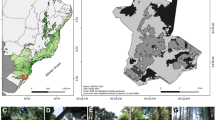Abstract
The cottonwood leaf beetle, Chrysomela scripta, is the most damaging insect affecting the production of Populus, an important source of sustainable forest products and biomass. Currently, there is no simple method for monitoring C. scripta populations, and nothing is known about potential chemical attractants for trapping. We conducted laboratory assays on sources of attraction to C. scripta adults. In olfactometer trials, beetles were attracted to volatiles released from conspecifics feeding on foliage. There was also significant, but lesser, attraction to odor from unwounded foliage, C. scripta alone, and frass. The latter two results indicate the presence of a pheromone. Wounding of foliage by C. scripta, but not by artificial means, enhanced its attractiveness compared to unwounded foliage, even when C. scripta by-products were removed. In direct comparisons, responses to odor from beetle-wounded foliage were not different from responses to odor from beetles feeding on foliage. We tested the attractiveness of volatiles emitted by adults feeding on foliage in the field using modified boll weevil traps. Results confirm that these volatiles are sufficient to increase trap catches in the field. Color is also important, with yellow baited traps catching more beetles than black baited. We propose that original landing by C. scripta is mediated by host odors and visual cues and that subsequent aggregation is enhanced by chemical cues associated with feeding by conspecifics. This may partially explain clustering in the field and likewise be incorporated into sampling schemes needed for integrated pest management.





Similar content being viewed by others
References
Bassman, J., Myers, W., Dickman, D. and Wilson, L. 1982. Effects of simulated insect damage on early growth of nursery-grown hybrid poplars in northern Wisconsin. Can. J. For. Res. 12:1–9.
Bolter, C. J., Dicke, M., Van Loon, J. J. A., Visser, J. H., and Posthumus, M. A. 1997. Attraction of Colorado potato beetle to herbivore-damaged plants during herbivory and after its termination. J. Chem. Ecol. 23:1003–1023.
Burkholder, W. E. and Ma, M. 1985. Pheromones for monitoring and control of stored-product insects. Annu. Rev. Entomol. 30:257–272.
Caldbeck, E. S., Mcnabb, H. S. J., and Hart, E. R. 1978. Poplar (Populus) clonal preferences of the cottonwood leaf beetle (Chrysomela scripta). J. Econ. Entomol. 71:518–520.
Coyle, D. R., Mcmillin, J. D., Hall, R. B., and Hart, E. R. 2002. Cottonwood leaf beetle (Coleoptera: Chrysomelidae) defoliation impact on Populus growth and above-ground volume in a short-rotation crop plantation. Agric. For. Entomol. 4:293–300.
Coyle, D. R., Nebeker, T. E., Hart, E. R., and Mattson, W. J. 2005. Biology and management of insect pests in North American intensively managed hardwood forest systems. Annu. Rev. Entomol. 50:1–29.
Hesler, L. S. and Sutter, G. R. 1993. Effect of trap color, volatile attractants, and type of toxic bait dispenser on captures of adult corn rootworm beetles (Coleoptera: Chrysomelidae). Environ. Entomol. 22:743–750.
Howse, P. E. 1998. Insect Pheromones and Their Use in Pest Management. Chapman and Hall, New York.
Kalberer, N. M., Turlings, T. C. J., and Rahier, M. 2001. Attraction of a leaf beetle (Oreina cacaliae) to damaged host plants. J. Chem. Ecol. 27:647–661.
Landolt, P. J. and Phillips, T. W. 1997. Host plant influences on sex pheromone behavior of phytophagous insects. Annu. Rev. Entomol. 42:371–391.
Landolt, P. J., Tumlinson, J. H., and Alborn, D. H. 1999. Attraction of Colorado potato beetle (Coleoptera: Chrysomelidae) to damaged and chemically induced potato plants. Environ. Entomol. 28:973–978.
Larson, P. R. and Isebrands, J. G. 1971. The plastochron index as applied to developmental studies of cottonwood. Can J. For. Res. 1:1–11.
Loughrin, J. H., Potter, D. A., and Hamilton-Kemp, T. R. 1995. Volatile compounds induced by herbivory act as aggregation kairomones for the Japanese beetle (Popillia japonica Newman). J. Chem. Ecol. 21:1457–1467.
Nebeker, T. E., Wariner, M. D., and Hart, E. R. 2002. Cottonwood fiber farm pest management: Cottonwood leaf beetle, pp. 565-568, in Gen. Tech. Rep. SRS-48. Asheville, NC: U.S. Department of Agriculture, Forest Service, Southern Research Station, pp. 565–568.
Peng, C. and Weiss, M. J. 1992. Evidence of an aggregation pheromone in the flea beetle Phyllotreta cruciferae (Goeze) (Coleoptera Chrysomelidae). J. Chem. Ecol. 18:875–884.
Reinecke, A., Ruther, J., and Hilker, M. 2002. The scent of food and defence: Green leaf volatiles and toluquinone as sex attractant mediate mate finding in the European cockchafer Melolontha melolontha. Ecol. Lett. 5:257–263.
Smyth, R. R. and Hoffman, M. P. 2003. A male-produced aggregation pheromone facilitating Acalymma vittatum (F.) (Coleoptera: Chrysomelidae) early-season host plant colonization. J. Insect Behav. 16:347–359.
Tansey, J. A., Mcclay, A. S., Cole, D. E., and Keddie, B. A. 2005. Evidence for the influence of conspecific chemical cues on Aphthona nigriscutis (Coleoptera: Chrysomelidae) behaviour and distribution. BioControl 50:343–358.
Tinzaara, W., Dicke, M., Van Huis, A., and Gold, C. S. 2002. Use of infochemicals in pest management with special reference to the banana weevil, Cosmopolites sordidus (Germar) (Coleoptera: Curculionidae). Insect Sci. Appl. 22:241–261.
Turlings, T. C. J., Tumlinson, J. H., and Lewis, W. J. 1990. Exploitation of herbivore-induced plant odors by host-seeking parasitic wasps. Science 250:1251–1253.
Vet, L. E. M. and Dicke, M. 1992. Ecology of infochemical use by natural enemies in a tritrophic context. Annu. Rev. Entomol. 37:141–172.
Visser, J. H. 1986. Host odor perception in phytophagous insects. Annu. Rev. Entomol. 31:121–144.
Wood, D. L. 1982. The role of pheromones, kairomones, and allomones in the host selection and colonization behavior of bark beetles. Annu. Rev. Entomol. 27:411–446.
Zehnder, G. and Speese, J. I. 1987. Assessment of color response and flight activity of Leptinotarsa decemlineata (Say) (Coleoptera Chrysomelidae) using window flight traps. Environ. Entomol. 16:1199–1202.
Acknowledgments
This research was supported by funds from the USDA Forest Service North Central Research Station and International Paper Company, and we express our gratitude to Don Riemenshcneider, Mike Young, and Scott Cameron. Olfactometer design was improved based on the recommendations of Alonso Suazo and Yasmin Cardoza, and Mark Allington was instrumental in their construction. Brian Aukema provided statistics consultation. Thanks to Lynn Hummel and Isaac Kabera for greenhouse support. We also thank Wynee Lou, Megan Hyslop, and Jason Jones for technical assistance with insects and plants. Rick Lindroth, Claudio Gratton, and David Coyle (UW-Madison Dept. of Entomology), Jun Zhu (UW-Madison Dept. of Statistics), and two anonymous reviewers provided valuable critiques of this manuscript.
Author information
Authors and Affiliations
Corresponding author
Rights and permissions
About this article
Cite this article
Kendrick, A.P., Raffa, K.F. Sources of Insect and Plant Volatiles Attractive to Cottonwood Leaf Beetles Feeding on Hybrid Poplar. J Chem Ecol 32, 2585–2594 (2006). https://doi.org/10.1007/s10886-006-9184-y
Published:
Issue Date:
DOI: https://doi.org/10.1007/s10886-006-9184-y




